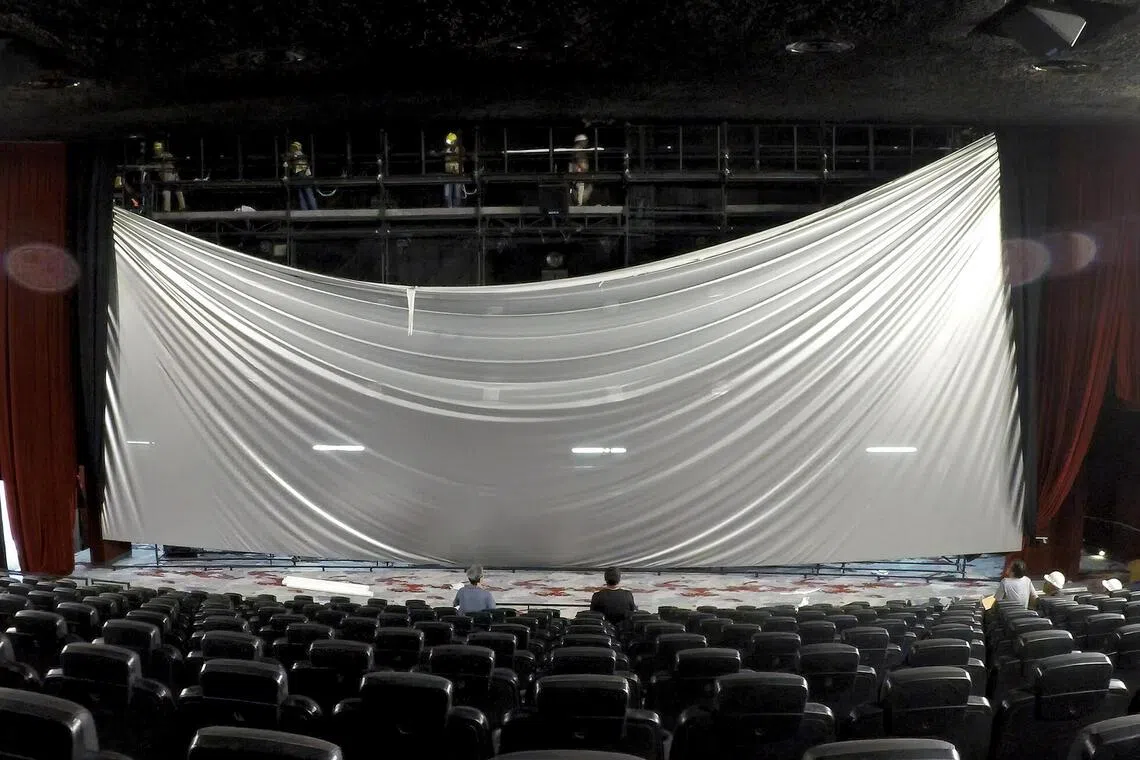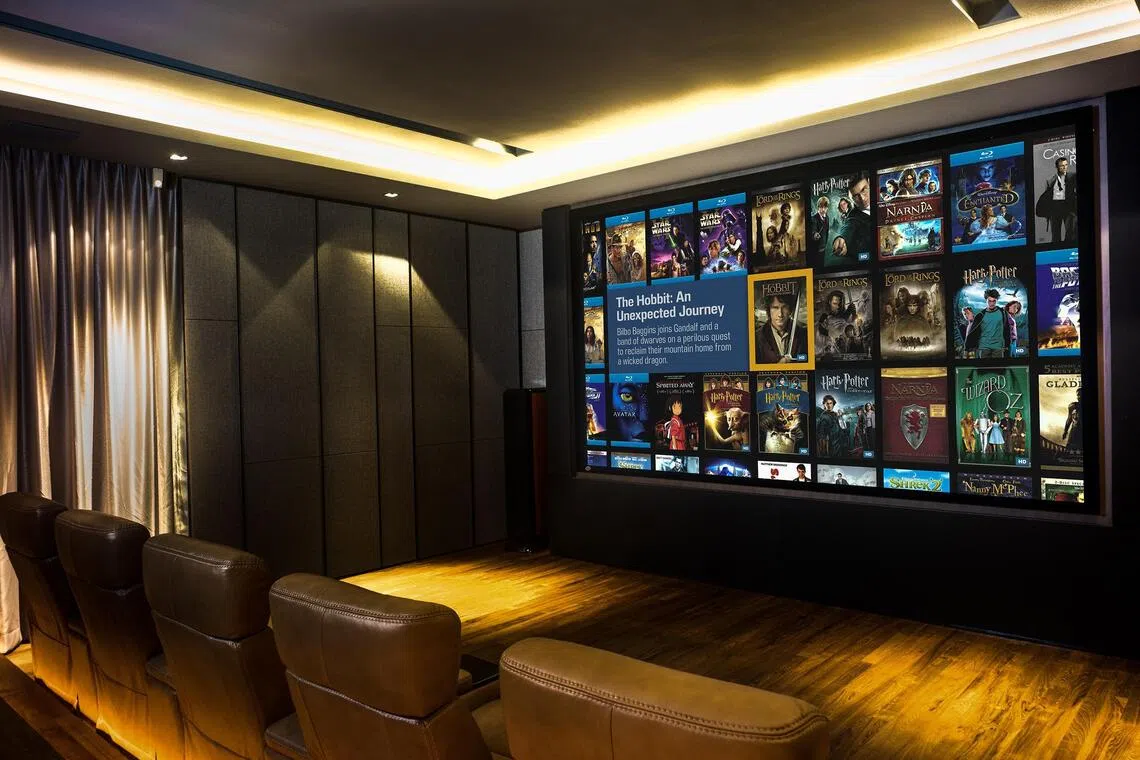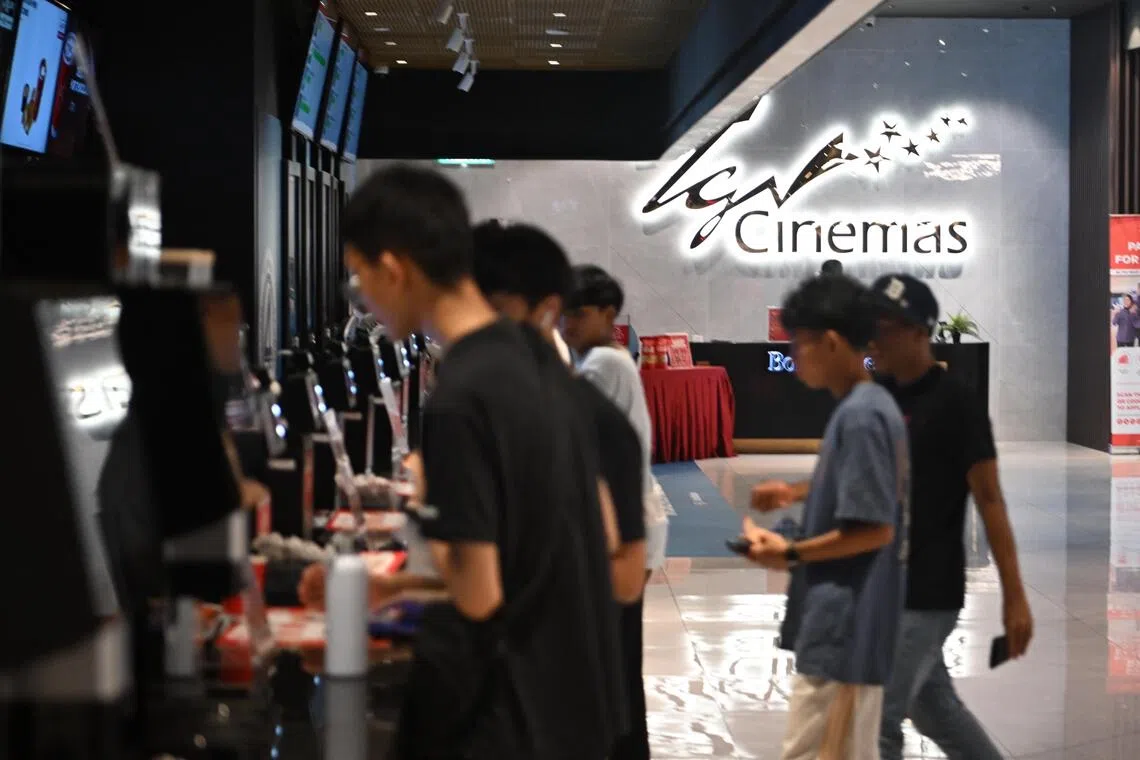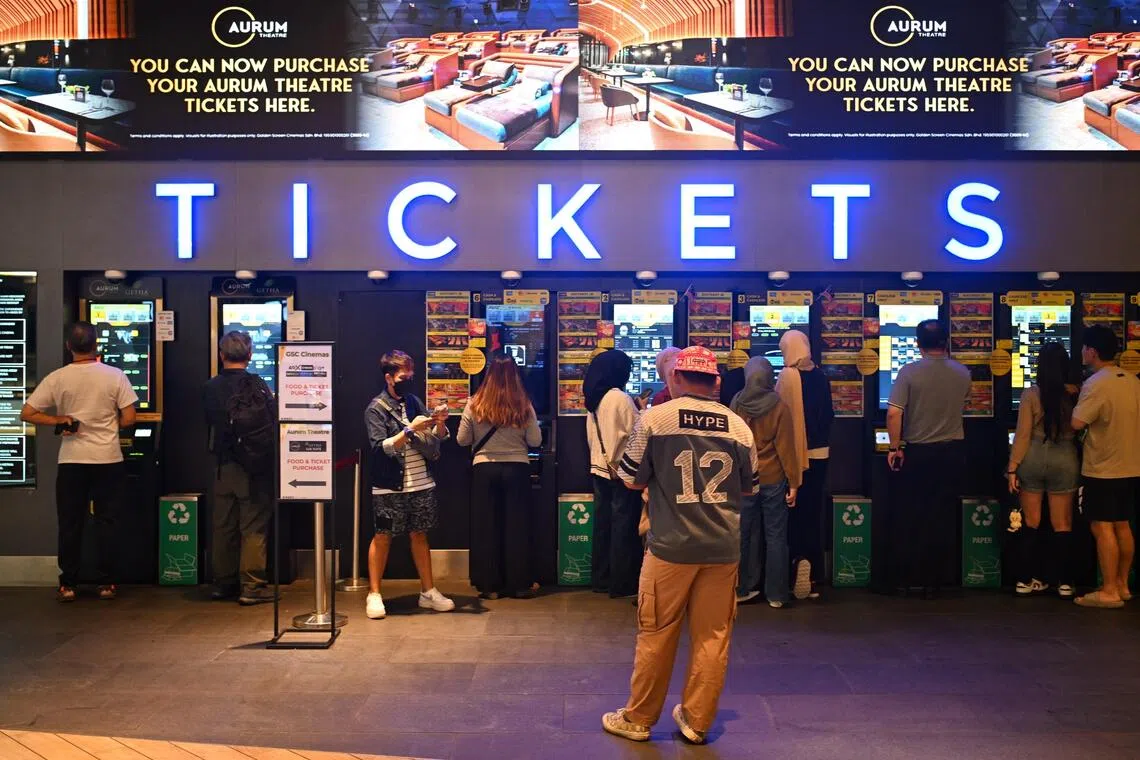JB cinemas are getting more popular with S’poreans. How are local operators upping their game?
Sign up now: Get ST's newsletters delivered to your inbox

Singaporeans are already regular visitors to JB cinemas (left).
PHOTOS: AZMI ATHNI, SHAW THEATRES
Follow topic:
- Shaw Theatres Lido will be reopening in phases from October with upgrades including laser projectors and new screens, addressing IMAX defects.
- Singapore cinema attendance fell by 54.5% from 2019-2024, attributed to home entertainment, Johor Bahru's cheaper options, and selective viewing habits.
- Cinema operators believe "elevated experience[s]" and alternative content like K-pop concerts can revive cinemas, despite declining Hollywood blockbuster appeal.
AI generated
SINGAPORE – When Shaw Theatres announced on Aug 25 on Facebook that Shaw Theatres Lido in Orchard Road would be closed for renovations from Sept 1, commenters cheered and offered suggestions.
Some asked for better-lit stairs and more premium halls. But most wanted an improved version of the Imax big-screen experience – a taller and brighter screen, for instance, without the defective panels that have plagued the current display for over a year, sparking anger on online forums like Reddit.
Mr Mark Shaw, director of the Shaw Organisation Group of Companies, tells The Straits Times the Lido cinemas will reopen in phases, starting from October.

The crew lowering the old Imax screen at Shaw Theatres Lido.
PHOTO: SHAW THEATRES
“The renovations will introduce some significant changes and upgrades. While some halls will reopen in October, renovation works will wrap up only towards the end of the year. Screenings for six of our regular halls, as well as our Imax hall, will resume on Oct 6,” he says.
Addressing the Imax screen complaints, he says the company shares patrons’ concerns. However, replacing an Imax screen involves complex logistics, and the new screen’s arrival, fortunately, coincides with the renovation plans.

The crew receiving the new Imax screen to be installed at Shaw Theatres Lido.
PHOTO: SHAW THEATRES
According to him, the upgrades will include new laser projectors for six halls – with the latest 4K laser projector in Lido 1 – and new screens for seven halls, including the flagship Imax screen.
Shaw Theatres did not disclose information about the new Imax screen dimensions. It is understood that its existing Imax screens cover walls from edge to edge, leaving little room for dimensional changes.
Mr Shaw adds that Shaw Theatres Jem in Jurong East will open in stages from November.
In May, Shaw Theatres announced it was taking over the space left by Cathay Cineplex Jem. It then closed the space for renovations.
“We decided to invest extra time to make significant changes,” Mr Shaw says.
Shaw Theatres’ upgrades come as the cinema industry is reeling from the closures of the 86-year-old Cathay Cineplexes chain on Sept 1
These blows follow Filmgarde’s shutting of its last theatre at Leisure Park Kallang in March
Patrons are gone, but could they return?
Despite population growth, Singaporeans are going to the movies less frequently.
Statistics provided by the Singapore Film Commission show that cinema attendance fell from 18.46 million in 2019 to 8.4 million in 2024, a sharp decline of 54.5 per cent. Over the same period, the number of screens fell slightly, from 281 to 267, a decline of just 5 per cent.
This disparity between the fall in attendance and the drop in screen numbers implies that operators sought to keep the supply constant even as demand shrank. The market correction came soon enough, leaving cinema chains Golden Village (GV) and Shaw Theatres as the survivors.

Falling attendance takes a toll: Cathay Cineplexes at Downtown East on Sept 1. A notice of provisional liquidation is seen at the ticketing counter.
ST PHOTO: ARIFFIN JAMAR
On the Facebook page of SPH Radio station One FM 91.3, a poll carried out at the request of ST shed some light. The survey posted on Sept 12 asked: “Why did you stop going to the cinema?”
Listeners like Justin Tay prefer to watch movies at home “where it’s more comfortable and convenient”. And Edi Poon says ticket prices – which can reach $16 each for blockbusters during peak periods in standard halls – are a deterrent and that “many titles are available online, after a while”.
On the Reddit social media site, user Hide88 wrote: “Don’t blame consumers when my TV at home has better picture quality.”
Mr Soon Ong, chief executive officer of Clarity Group, a Singapore-based technology lifestyle firm specialising in private cinemas and smart home systems, says that while the overall number of home installations has not risen sharply, their value and sophistication have. In Singapore, the company’s work covers smaller private cinema spaces to larger immersive environments, including some that cost more than $300,000.

Singaporeans are turning rooms in their homes into cinemas. In this $300,000 Clarity Private Cinema installation in a bungalow in the east, the home owner enjoys movies and music in the room which can fit 10 to 15 people.
PHOTO: CLARITY GROUP
“Cinema at home is no longer about luxury for the sake of it, but about recreating the magic of the movies with quality, comfort and exclusivity, free from the distractions of a commercial theatre,” he says.
Mr Goh Chuan Hock, deputy manager for the Diploma in Media & Communication Management at Nanyang Polytechnic’s School of Business Management, agrees.
“The consumer behaviour changes we’ve observed, particularly the shift towards streaming and more selective cinema attendance, appear permanent. This isn’t a temporary downturn but a structural shift,” he says.
He believes that cinemas with higher rental costs and weak footfall are most at risk. He adds that the most vulnerable cinemas are older ones in suburban locations in zones where several outlets are within easy reach of consumers, or those in the Central Business District and Orchard Road which draw crowds only on weekends.
Better options across the border

The ticketing booth at GSC cinema at KSL City Mall in Johor Bahru.
ST PHOTO: AZMI ATHNI
It is not just better home entertainment options that have gobbled up consumer dollars. Movie fans in Singapore have long discussed Johor Bahru’s (JB) better price-to-quality ratio.
From January to July 2025, there were more than 11 million Singaporean visits to the Malaysian state of Johor, representing a 22.5 per cent increase over the same period in 2024.
After the Johor Bahru-Singapore Rapid Transit System Link begins operation in December 2026
This new mode of transport will make it easier for Singaporeans to enjoy JB’s cheaper movie ticket prices – which top out at about $10 – and cinema amenities, including newer projection equipment, more comfortable seating and kids’ playrooms. Mall amenities like splash parks and restaurants are a draw too.

TGV Cinemas at Toppen Shopping Centre in Johor Bahru.
ST PHOTO: AZMI ATHNI
Singaporeans are already regular visitors to JB cinemas. A manager at GSC Mid Valley Southkey says the group makes up around 30 per cent of weekend audiences, with slightly lower numbers on weekdays. Mandarin and Cantonese films are particularly in demand.
Popular cinema chains include GSC – with locations at KSL City Mall, and The Mall, Mid Valley Southkey, including the luxury Aurum Theatre option – and TGV at Toppen Shopping Centre.
A standard weekday ticket at GSC KSL City Mall costs RM12 (S$3.60), while a peak ticket costs RM19. The baseline offering includes wide leatherette seats with generous legroom.

The ticketing counter at GSC cinema at The Mall, Mid Valley Southkey in Johor Bahru.
ST PHOTO: AZMI ATHNI
But Nanyang Polytechnic’s Mr Goh believes that Singapore cinemas retain the convenience advantage despite easier cross-border travel, “particularly for price-conscious consumers seeking combined entertainment experiences”.
He adds: “Weekday cinema habits remain fundamentally about convenience. Most people won’t cross the border just to catch a 9pm show after work.”
Can horror, K-pop and anime save cinemas?
Mr Shaw says the gloomy market outlook is not the reason for Shaw Theatres’ upgrades.
Neither GV nor Shaw supports the permanent “structural shift” narrative of consumer behaviour put forward by Mr Goh.
Mr Shaw says the Lido upgrades were planned well in advance and will help the cinema reach new market segments. The extended works at Jem stem from “our mission to offer our patrons an elevated cinema experience”.
Surprise hits of 2025, like the horror-musical Sinners as well as Chinese animated fantasy Ne Zha 2 and Chinese historical drama Dead To Rights, “show the resilience of the cinema experience”, he insists.
Alternative content such as BTS Movie Weeks

A remastered version of BTS 2019 World Tour Love Yourself: Speak Yourself concert in London is being screened in Singapore as part of BTS Movie Weeks.
PHOTO: HYBE
A spokesperson for GV rejects the idea of an “inevitable decline”.
“What’s happening is a shift. Audiences are becoming more selective, choosing experiences that feel that they are worth leaving home for. Younger audiences want communal energy and unique live experiences that can’t be replicated on streaming,” says the spokesperson.
Over the next decade, the market will be bolstered by two trends: large-scale event movies like the Avatar (2009 to present) sci-fi fantasy franchise and the Demon Slayer (2020 to present) anime series, and niche experiences where cinemas act as cultural hubs, offering content not found on streaming platforms. These include fan meets, K-pop virtual-reality movie screenings and stand-up comedy shows, says the spokesperson.

Anime movies such as Demon Slayer: Kimetsu No Yaiba – The Movie: Infinity Castle can make up for the lack of appeal of Hollywood films, say cinema operators.
PHOTO: SONY PICTURES
Mr Kenneth Tan, chairman of the Singapore Film Society (SFS) and former managing director of Golden Village Multiplex, attributes the industry’s struggles largely to Hollywood’s declining appeal.
“Blockbusters aren’t getting the kind of response they used to,” he says.
Global box-office figures bear this out. Despite record-breakers like superhero movie Deadpool & Wolverine (2024), there has been a 7 per cent decline in takings in 2024 compared with 2023. The 2023 Hollywood strikes and lingering Covid-19 effects likely contributed to that.
Yet, Mr Tan sees hope. Two kinds of films will thrive: curated festival films and what he calls “wow experiences” – movies with an unmissable hook. He cites the example of Taiwanese film-maker Hou Hsiao-hsien’s A City Of Sadness (1989). The 4K restoration of the war drama was screened at the Singapore Chinese Film Festival in 2024, with tickets selling out in under a day.
In addition, 2024’s Japanese Film Festival Singapore, co-organised by the SFS, garnered an unprecedented 7,000 admissions, he says.
“I will stake my entire career on this statement: Cinema is alive and well. But we need to curate and provide the wow communal experience,” he adds.
Mr Jeremy Chua, general manager of the Singapore International Film Festival, echoes the need for curation to bring people back to the cinema. But he adds that government agencies and cultural institutions can do their part by reducing the inequality in the industry, where “a few movies make large profits and the overwhelming majority suffer a loss”.
“We need policies that create a counterbalance, to address the needs of independent cinemas and film-makers,” he says.
Nanyang Polytechnic’s Mr Goh believes Singapore cinemas should focus on weekday convenience rather than compete for weekend leisure trips to JB.
Clear subscription models are key. He suggests unlimited viewing passes with transparent pricing, removing the friction of deciding whether each visit is worth the cost.
Programming must also treat Asian and regional films as mainstream, not niche content.
Mr Goh says: “Continuous improvement is crucial: superior comfort, consistent technical presentation with expanded premium formats, and diverse programming that treats regional titles and event screenings as core offerings rather than niche content.
“If home is the default, the cinema must feel like the upgrade, every time.”


